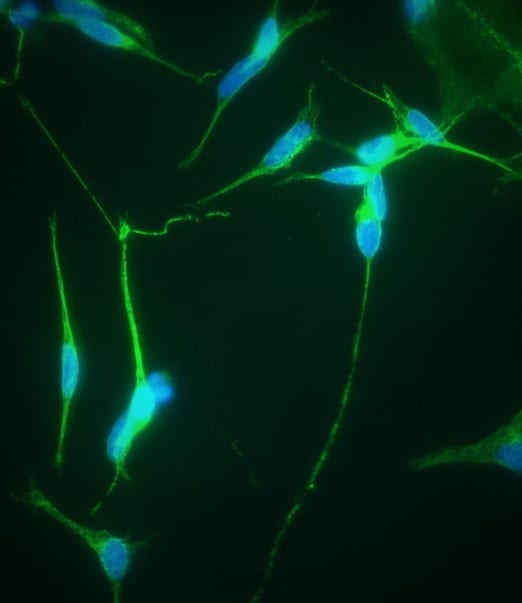Vanderbilt University Medical Center nephrologist and Associate Professor of Medicine Dr. William H. Fissell IV, is making major progress on a first-of-its kind device to free kidney patients from dialysis. He is building an implantable artificial kidney with microchip filters and living kidney cells that will be powered by a patient’s own heart.
“We are creating a bio-hybrid device that can mimic a kidney to remove enough waste products, salt and water to keep a patient off dialysis,” said Fissell.
Fissell says the goal is to make it small enough, roughly the size of a soda can, to be implanted inside a patient’s body.
The key to the device is a microchip.
“It’s called silicon nanotechnology. It uses the same processes that were developed by the microelectronics industry for computers,” said Fissell.
The chips are affordable, precise and make ideal filters. Fissell and his team are designing each pore in the filter one by one based on what they want that pore to do. Each device will hold roughly fifteen microchips layered on top of each other.
But the microchips have another essential role beyond filtering.
“They’re also the scaffold in which living kidney cells will rest,” said Fissell.
Fissell and his team use live kidney cells that will grow on and around the microchip filters. The goal is for these cells to mimic the natural actions of the kidney.
“We can leverage Mother Nature’s 60 million years of research and development and use kidney cells that fortunately for us grow well in the lab dish, and grow them into a bioreactor of living cells that will be the only ‘Santa Claus’ membrane in the world: the only membrane that will know which chemicals have been naughty and which have been nice. Then they can reabsorb the nutrients your body needs and discard the wastes your body desperately wants to get rid of,” said Fissell.
Because this bio-hybrid device sits out of reach from the body’s immune response, it is protected from rejection.
“The issue is not one of immune compliance, of matching, like it is with an organ transplant,” said Fissell.
The device operates naturally with a patient’s blood flow.
“Our challenge is to take blood in a blood vessel and push it through the device. We must transform that unsteady pulsating blood flow in the arteries and move it through an artificial device without clotting or damage.”
And that’s where Vanderbilt biomedical engineer Amanda Buck comes in. Buck is using fluid dynamics to see if there are certain regions in the device that might cause clotting.
“It’s fun to go in and work in a field that I love, fluid mechanics, and get to see it help somebody,” said Buck.
Vanderbilt biomedical engineer Amanda Buck is using fluid dynamics to see if there are certain regions in the device that might cause clotting.
Fissell says he has a long list of dialysis patients eager to join a future human trial. Pilot studies of the silicon filters could start in patients by the end of 2017.
The Latest on: Artificial Kidney
[google_news title=”” keyword=”Artificial Kidney” num_posts=”10″ blurb_length=”0″ show_thumb=”left”]
via Google News
The Latest on: Artificial Kidney
- How the Black Opry, Beyoncé are helping elevate artists of color in country musicon April 28, 2024 at 5:36 am
Before there was conversation over whether Beyoncé is country enough for country music, there was the Black Opry, holding space for music lovers and artists of color in the genre. The organization ...
- Is Artificial Protein Powder Killing You Or Building You? All You Need To Knowon April 27, 2024 at 11:31 pm
While none was directly related to intake of protein powders or supplements, those huge jars of artificial nutrition definitely have an impact on liver and kidney. With all the buzz around its safety, ...
- MIT Technology Reviewon April 27, 2024 at 9:51 am
This is what the priorities in the $95 billion spending package tell us about four military technologies and the way they’re reshaping how war is fought. Researchers are using generative AI and other ...
- Forget Nvidia, These Unstoppable Stocks Are Better Buyson April 27, 2024 at 8:10 am
These stocks have tremendous potential, and it doesn't depend on the growth prospects for artificial intelligence.
- Ask the doctors: Hemodialysis allows machine to act as artificial kidneyon April 27, 2024 at 6:15 am
When either illness or injury lead to kidney failure, dialysis becomes necessary. This is a treatment that helps the kidneys with their job of filtration. The most common form is hemodialysis, the ...
- Best dry dog food for your pup, according to veterinarianson April 26, 2024 at 8:24 am
Did you adopt a dog or want to change your dog’s dry food brand? These veterinarians have advice on the best dry dog food to buy and which kibble to avoid.
- Smaller towns in South Korea bear brunt of doctors’ shortageon April 26, 2024 at 12:08 am
Seoul, the capital, boasts top-level hospitals, but smaller cities are starved of doctors in a trend experts say will only get worse as the population ages at one of the world's fastest rates, while ...
- Grandmother gets new lease on life from heart pump, pig kidneyon April 25, 2024 at 5:23 pm
A grandmother on the brink of death received an experimental surgery earlier this month, getting a new heart valve and a kidney from a gene-edited pig ...
- SCOTUS considers whether Idaho abortion ban conflicts with federal law | The Excerpton April 25, 2024 at 11:56 am
Plus: A grand jury has charged Arizona Republicans and former aides to Donald Trump in a scheme to falsely claim he won the state in 2020.
- Movie review: Vampire-heavy 'Abigail' has more bite than barkon April 23, 2024 at 5:00 pm
“Abigail” looks like it’s going to be a horror film about dance. Five minutes in, you realize ballet is a ruse. This is simply a vampire film dressed up in tutus. Remarkably, we don’t get the heads up ...
via Bing News












